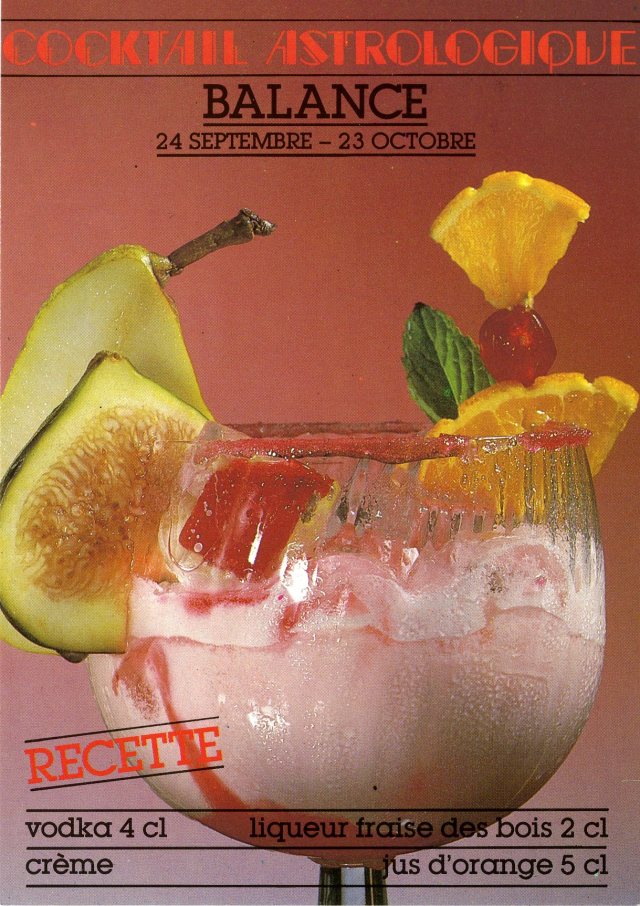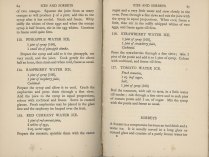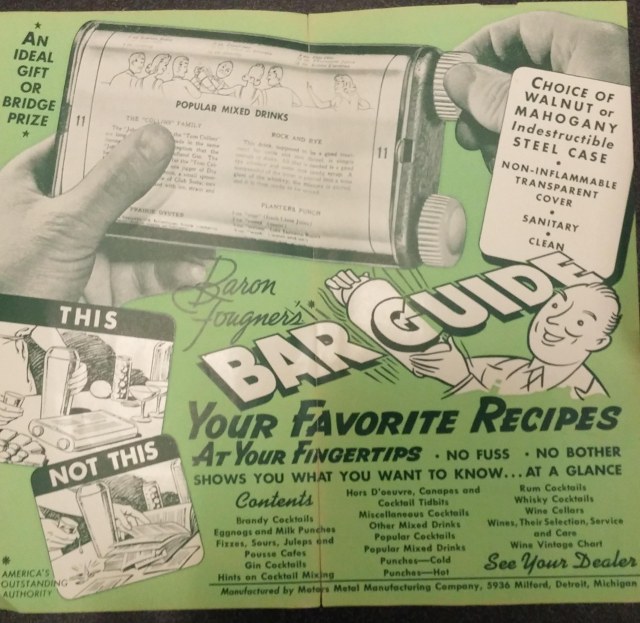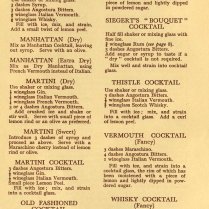Charles H. Baker, Jr. (1895-1987), was a salesman turned writer and magazine publisher turned columnist. After spending many years traveling the globe, writing columns for a variety of magazines, including Esquire, Town & Country, and Gourmet, he compiled items from his on-going column, “Here’s How,” as well as other writings, into The Gentleman’s Companion, first published in 1939. It included two volumes, which are the same two we have in our 1946 edition: Volume I Being an Exotic Cookery Book, or Around the World with a Knife Fork and Spoon and Volume II Being an Exotic Drinking Book or, Around the World with Jigger, Beaker and Flask.

Frontispiece and title page, The Gentleman’s Companion, Vol. 1, 1946

Table of contents, The Gentleman’s Companion, Vol. 1, 1946

Recipes, The Gentleman’s Companion, Vol. 1, 1946

Recipes, The Gentleman’s Companion, Vol. 1, 1946
Dedication [Volume I]
Contrary to current routine this volume is not dedicated to Publisher, Wife, Friend, Mistress or Patron, but to our own handsome digestive tract without which it never could have seen light of day.
Although it may be difficult to trace and explore, I might be tempted to give Baker some credit for the boom of American interest in what was considered ethnic and/or exotic cuisine in the 1950s and 1960s. Of course, there are many, MANY factors for this interest (including World War II and woman’s magazines, to name a couple), but Baker definitely brought a new perspective on world cuisine to American audiences.
A Soup of plump & gentle fowls of discreet age, and red ripe bananas, á Santiago
Proceed as in the Grecian dish, and when broth is done and you have a qt proceed as follows: Reserve breast and trim into shreds the size of matchsticks, cutting with the grain. To the rich broth add 2 red bananas, stood in sun until well ripened; simmer 10 minutes slowly, and rub through sieve or put in The Blender. Serve hot with a pinch of nutmeg on top.
This number was collected during a visit to Santiago and subsequent to an afternoon’s visit to the factory of Bacardi, being escorted thither by a late member of that illustrious family. It was, all in all, a memorable day. For several reasons.
While availability of ingredients in the United States might still be limited at this time–red bananas being a prime example–there are contemporary pamphlets and publications from the organizations like the United Fruit Company which were bringing some surprising and unique banana dishes into kitchens everywhere. And, Baker was doing much the same for cocktails in the second volume.

Frontispiece and title page, The Gentleman’s Companion, Vol. 2, 1946

Table of contents, The Gentleman’s Companion, Vol. 2, 1946

Recipes, The Gentleman’s Companion, Vol. 2, 1946

Recipes, The Gentleman’s Companion, Vol. 2, 1946
Dedication [Volume II]
To all that Company of Friends, from Pine to Palm, with whom we have So Happily Raised the Glass.
It’s worth noting here that Baker does something that you see more commonly before the 1930s/40s and much less so in cocktail book after the 1940s: commentary. Sometimes it’s a single sentence explanation of (like the Turf Cocktail No. III’s “from the Havana Country Club, Winter of 1930”) and other times, as with “The Hallelujah Cocktail” from Panama, the comments before and after the recipe are nearly a page long. Not every cocktail has an explanation, the majority have something–largely, I suspect, because so many of these recipes were not found in American bars just yet. His cocktails really are global, and while the recipes are an important part, Baker is clearly a story-teller, too. As a Florida native, he managed to cross paths with Southern writers fond of a good libation and he doesn’t hesitate to share:
A Farewell to Hemingway, being a sort of Kirch Collins we invented the night we say Hemingway & bull-fighter Sidney Franklin off on the plane for New York, & Loyalist Spain
There is no reason to this drink. It just happened because Ernest prefers kirschwasser, and it was a muggy, half-breathless sort of night. The cherry syrup sweet, of course, can be varied to taste…Take 1 1/2 jiggers of kirsch, 1/4 pony of cherry syrup–again the drug store kind–and the juice of 1 big green lime. Shake this mixture with 4 ice cubes, turn ice and all into a collins glass of at least 14 oz capacity, drop in a spiral peel of green lime, and fill glass not quite full with good chilled club soda….We’ve later found out that raspberry syrup is very decent, too.
Hemingway did really have a taste for cherry liqueurs, by the way. The “Hemingway Daiquiri” (also called the “Papa Doble”) drops the usual sugar or simple syrup present in most daiquiris, but adds grapefruit juice and maraschino liqueur. (“Papa” Hemingway’s recipe is my go-to daiquiri in the summer.)
Neither the 1939, nor the 1946 editions deterred Baker from his travels or writings and in 1951, Baker published both The South American Gentleman’s Companion: Vol. 1, Being an Exotic Cookery Book or, Up and Down the Andes with Knife, Fork and Spoon and The South American Gentleman’s Companion: Vol. 2, Being an Exotic Drinking Book or, Up and Down the Andes with Jigger, Beaker and Flask. (Sadly, we don’t currently have this set in our collection.) Not to be outdone–or perhaps to outdo himself–in 1959, he wrote The Esquire Culinary Companion, Being an Exotic Cookery Book; or, Around Europe with Knife, Fork, and Spoon (although there isn’t a copy in Special Collections, the library has one you can request). This last book was only a single volume, but is anyone else sensing a theme among his titles?
Baker did write a single novel in 1946 (Blood of the Lamb), but it wasn’t nearly as well-received as his cocktail and culinary musings, which remain of interest to collectors and collections today (and hopefully, to some scholars, too!). You can acquire modern reprints these days, too. Due to its more “recent” publication dates, all Baker’s versions of The Gentleman’s Companion are still under copyright, so you won’t likely find them online in their entirety. But, you’re always welcome to come and view ours.

 Figs and pears, anyone? (Actually, this rather reminds me of some of Jerry Thomas’ ornately garnished drinks of the 1860s…)
Figs and pears, anyone? (Actually, this rather reminds me of some of Jerry Thomas’ ornately garnished drinks of the 1860s…)








































































